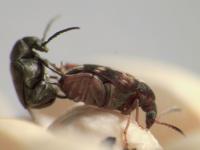[dropcap style=”font-size:100px; color:#992211;”]M[/dropcap]ove over, curly. It’s not size that matters, it’s shape (if you’re a beetle).
When a female mates with several males, these will compete over the fertilization her eggs.
This is an important evolutionary force that has led to the evolution of a diversity of male sexual organ morphologies. This is revealed in a study of seed beetles published today in the leading scientific journal Current Biology.
In higher plants, the influential classification system developed by Carl von Linnaeus relied on the fact that the reproductive parts of plants are evolutionarily stable. This is in sharp contrast to the reproductive organs of animals with internal fertilization, where the sexual organs change most rapidly of all morphological features during evolution. In virtually all groups of animals, from roundworms and molluscs to reptiles and mammals, the male sex organs differ markedly between even closely related species.
[quote]the sexual organs change most rapidly of all morphological features during evolution[/quote]
In a new collaborative project, researchers at Uppsala University and the University of Cincinnati have now for the first time been able to clarify the evolutionary force that underlies this rapid evolution in in seed beetles (Callosobruchus maculatus).
Our results show that the morphology of the male genitalia affects his fertilization success in these beetles. Because females mate with multiple males, the function of the male copulatory organ determines which of the males will fertilize her eggs, says the project’s scientific director Professor Göran Arnqvist.
This competition among males has generated a great biological diversity and we believe that it has directly contributed to the formation of new species.
###
This study was made possible by changing the morphology of the male genitalia of these beetles, through both micro-laser technology and genetic experiments.
The study was funded by, among others, the European Research Council and the Swedish Research Council.
Source:Uppsala University

The aim of art is to represent not the outward appearance of things, but their inward significance. – Aristotle





















